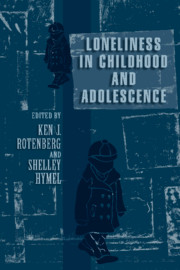Book contents
- Frontmatter
- Contents
- Contributors
- PART I INTRODUCTION
- PART II THEORETICAL AND ASSESSMENT ISSUES
- 2 The Conceptualization and Measurement of Childhood Loneliness
- 3 Understanding the Origins of Childhood Loneliness: Contributions of Attachment Theory
- 4 Developmental Change in the Sources of Loneliness in Childhood and Adolescence: Constructing a Theoretical Model
- 5 Loneliness Through the Eyes of Children
- PART III LONELINESS IN CHILDHOOD
- PART IV LONELINESS IN ADOLESCENCE
- PART V PROSPECTIVE
- References
- Author Index
- Subject Index
- Plate section
5 - Loneliness Through the Eyes of Children
Published online by Cambridge University Press: 13 October 2009
- Frontmatter
- Contents
- Contributors
- PART I INTRODUCTION
- PART II THEORETICAL AND ASSESSMENT ISSUES
- 2 The Conceptualization and Measurement of Childhood Loneliness
- 3 Understanding the Origins of Childhood Loneliness: Contributions of Attachment Theory
- 4 Developmental Change in the Sources of Loneliness in Childhood and Adolescence: Constructing a Theoretical Model
- 5 Loneliness Through the Eyes of Children
- PART III LONELINESS IN CHILDHOOD
- PART IV LONELINESS IN ADOLESCENCE
- PART V PROSPECTIVE
- References
- Author Index
- Subject Index
- Plate section
Summary
In the 1970s and 1980s, a great deal of social psychological research was directed toward the study of loneliness in adults. Among the issues addressed in this literature were the perceived causes of loneliness, the nature of the interpersonal deficits implicated in the experience of loneliness, the measurement of loneliness, and the strategies used to cope with loneliness (e.g., see Peplau & Perlman, 1982a; Perlman & Landolt, this volume; Rook, 1984, for reviews). Investigators appear to have converged on the idea that the rather common experience of loneliness was in fact a very differentiated phenomenon because the nature and expression of loneliness could vary according to its duration, the type of the relational deficits involved, and its motivational and behavioral correlates (Rook, 1984). In short, a consensus had emerged that loneliness is a multidimensional phenomenon, at least among adults.
Inspired by efforts in the area of adult loneliness, developmental and clinical psychologists have shown an increasing concern for children's experience of loneliness (e.g., Asher et al., 1990; Margalit, 1994). Though it had been suggested (Sullivan, 1953; Weiss, 1973) that true loneliness cannot be experienced until preadolescence or adolescence, more recent analyses (e.g., Burgess, Ladd, Kochenderfer, Lambert, & Birch, this volume; Cassidy & Asher, 1992; Youngblade, Berlin, & Belsky, this volume) have shown that even younger children, no less often and perhaps no less deeply than adults, are well acquainted with the experience of loneliness. Unlike psychological accounts of loneliness in adult populations, however, research in the area of children's loneliness, with few exceptions (e.g., Marcoen et al., 1987), has yet to appreciate fully the multidimensional nature of the phenomenon as it takes shape in children's lives.
- Type
- Chapter
- Information
- Loneliness in Childhood and Adolescence , pp. 80 - 106Publisher: Cambridge University PressPrint publication year: 1999
- 29
- Cited by

